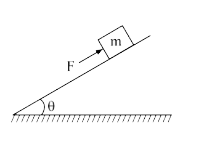The force required to just move a body up an inclined plane is double the force the required prevent it from sliding down. If phi is angle of friction and theta is the angle which incline makes with the horizontal then,
The correct Answer is:C
To solve the problem, we need to analyze the forces acting on a body placed on an inclined plane and derive the relationship between the angles of friction (φ) and the incline (θ).
1. Identify Forces Acting on the Body:
- When the body is about to move up the incline, the forces acting on it include:
- The gravitational force component down the incline: mgsinθ
- The frictional force acting downwards: f=μsN=μs(mgcosθ)
- When the body is about to slide down, the frictional force acts upwards.
2. Set Up the Equations:
- For the body moving upwards (force F1):
F1=mgsinθ+f=mgsinθ+μs(mgcosθ)
- For the body sliding down (force F2):
F2=mgsinθ−f=mgsinθ−μs(mgcosθ)
3. Given Condition:
- According to the problem, the force required to move the body up the incline is double the force required to prevent it from sliding down:
F1=2F2
4. Substituting the Expressions:
- Substitute F1 and F2 into the equation:
mgsinθ+μs(mgcosθ)=2(mgsinθ−μs(mgcosθ))
5. Simplifying the Equation:
- Distributing the 2 on the right side:
mgsinθ+μs(mgcosθ)=2mgsinθ−2μs(mgcosθ)
- Rearranging gives:
mgsinθ+μs(mgcosθ)+2μs(mgcosθ)=2mgsinθ
- Combine like terms:
mgsinθ+3μs(mgcosθ)=2mgsinθ
6. Isolate Terms:
- Move mgsinθ to the right:
3μs(mgcosθ)=2mgsinθ−mgsinθ
- This simplifies to:
3μs(mgcosθ)=mgsinθ
7. Canceling mg:
- Since mg is common in all terms, we can cancel it out:
3μscosθ=sinθ
8. Substituting for μs:
- Recall that μs=tanϕ:
3tanϕcosθ=sinθ
9. Using Trigonometric Identity:
- Divide both sides by cosθ:
3tanϕ=tanθ
10. Final Relation:
- Thus, we have the relationship:
tanθ=3tanϕ
Final Answer:
The relationship between the angles is:
tanθ=3tanϕ
- When the body is about to move up the incline, the forces acting on it include:
- The gravitational force component down the incline: mgsinθ
- The frictional force acting downwards: f=μsN=μs(mgcosθ)
- When the body is about to slide down, the frictional force acts upwards.
- For the body moving upwards (force F1):
F1=mgsinθ+f=mgsinθ+μs(mgcosθ)
- For the body sliding down (force F2):
F2=mgsinθ−f=mgsinθ−μs(mgcosθ)
- According to the problem, the force required to move the body up the incline is double the force required to prevent it from sliding down:
F1=2F2
- Substitute F1 and F2 into the equation:
mgsinθ+μs(mgcosθ)=2(mgsinθ−μs(mgcosθ))
- Distributing the 2 on the right side:
mgsinθ+μs(mgcosθ)=2mgsinθ−2μs(mgcosθ)
- Rearranging gives:
mgsinθ+μs(mgcosθ)+2μs(mgcosθ)=2mgsinθ
- Combine like terms:
mgsinθ+3μs(mgcosθ)=2mgsinθ
- Move mgsinθ to the right:
3μs(mgcosθ)=2mgsinθ−mgsinθ
- This simplifies to:
3μs(mgcosθ)=mgsinθ
- Since mg is common in all terms, we can cancel it out:
3μscosθ=sinθ
- Recall that μs=tanϕ:
3tanϕcosθ=sinθ
- Divide both sides by cosθ:
3tanϕ=tanθ
- Thus, we have the relationship:
tanθ=3tanϕ
The relationship between the angles is:
tanθ=3tanϕ
Topper's Solved these Questions
- NEWTONS LAWS OF MOTIONBook:A2ZChapter:NEWTONS LAWS OF MOTIONExercise:AIIMS Questions
Explore 26 Videos
- MOTION IN TWO DIMENSIONBook:A2ZChapter:MOTION IN TWO DIMENSIONExercise:Chapter Test
Explore 29 Videos
- OSCILLATION AND SIMPLE HARMONIC MOTIONBook:A2ZChapter:OSCILLATION AND SIMPLE HARMONIC MOTIONExercise:Chapter Test
Explore 29 Videos
Similar Questions
The force required to move a body up a rough inclined plane is double the force required to prevent the body from sliding down the plane. The coefficient of friction when the angle of inclination of the plane is 60∘ is
View SolutionThe force required to move a body up a rough inclined plane is double the force required to prevent the body from sliding down the plane. The coefficient of friction when the angle of inclination of the plane is 60∘ is .
View Solution
Knowledge Check
The force required just to move a body up an inclined plane is double the force required just to prevent the body sliding down. If the coefficient of friction is 0.25 , the angle of inclination of the plane is
A30∘B45∘Ctan−1(14)Dtan−1(34)The force required to just move a body up the inclined plane is double the force required to just prevent the body from sliding down the plane. The coefficient of friction is μ. If θ is the angle of inclination of the plane than tanθ is equal to
AμB3μC2μD0.5μThe force F1 required to just moving a body up an inclined plane is double the force F2 required to just prevent the body from sliding down the plane. The coefficient of friction is μ. The inclination θ of the plane is :
Atan−1μBtan−1μ2Ctan−12μDtan−13μ
In the situation shown, the force required to just move a body up an inclined plane is double the force required to just prevent the body from sliding down the plane. The coefficient of friction between the block and plane is μ. The angle of inclination of the plane from horizontal is given by :

View SolutionThe minimum force required to move a body up on an inclined plane is three times the minimum force required to prevent it from sliding down the plane.If the coefficient of friction between the body and the inclined plane is 12√3 the angle of the inclined plane is
View SolutionThe minimum force required to move a body up on an inclined plane is three times the minimum force required to prevent it from sliding down the plane. If the coefficient of friction between the body and the inclined plane is 12√3 the angle of the inclined plane is
View SolutionThe force F1 that is necessary to move a body up an inclined plane is double the force F2 that is necessary to just prevent it form sliding down, then:
View SolutionThe minimum force required to move a body up an inclined plane of inclination 30° is found to be thrice the minimum force required to prevent if from sliding down the plane. The co-efficient of friction between the body and the plane is -
View Solution

